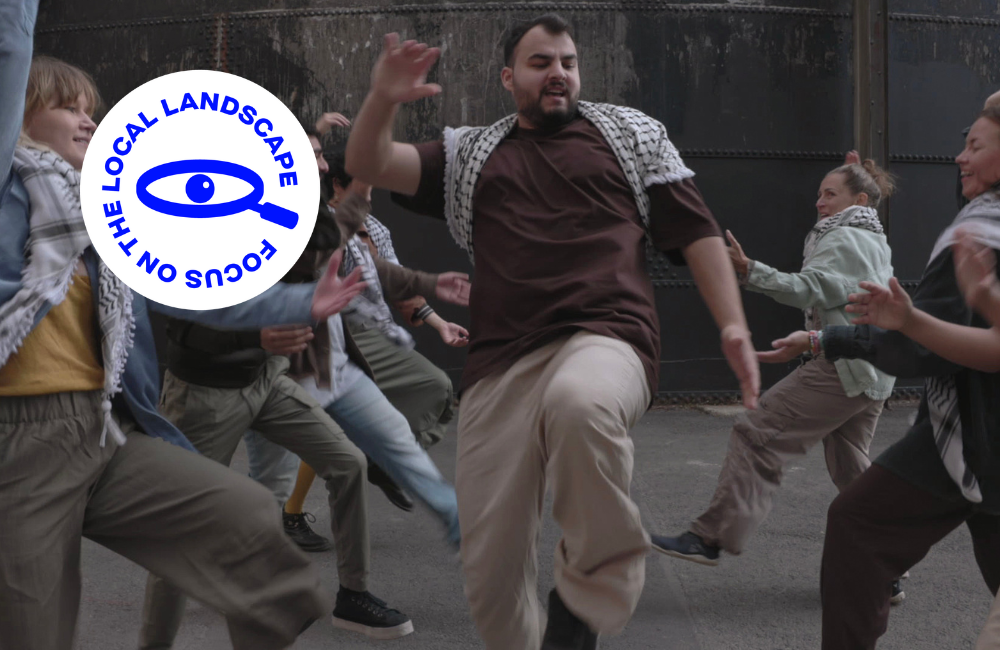
Could you tell us about the background and starting point of your movie?
Laura & Bianca:
The short film Their eyes will sear holes in the night sky is one manifestation of a longer research project looking at how migration and displacement transform dance practices. We initially focused on reading and researching more on a conceptual level, but when we encountered the group Al Huriya Dabke in Helsinki, the ideas materialized clearly and tangibly.
Tareq:
Al Huriya Dabke was founded out of a deep love for Palestine and its vibrant cultural heritage, expressed through the traditional Palestinian dance dabke. Our members include Palestinian dancers who grew up in Palestine performing dabke at weddings, celebrations, and cultural gatherings, where the dance has always been more than just movement, but a shared expression of identity, unity, and joy. Now in Finland, we carry this living tradition forward, preserving and celebrating it while introducing Palestinian culture to new audiences. Through rhythm and movement, we continue telling stories of resilience, belonging, and freedom—the essence of huriya (freedom) itself.
Laura & Bianca:
The dedication of the group’s participants to preserve and share Palestinian culture through dance, even in the face of erasure, has been deeply moving and undeniably powerful. Through conversations, shared time, and witnessing their weekly rehearsals, we learned so much about the history of dabke, as well as about the broader history of the Palestinian people and how this dance has long been tied to land, displacement, and resistance.
The video takes on a hybrid form, a blend of rehearsals, trials, and mistakes, interwoven with the fierceness and determination of performing and sharing. This hybridity also mirrors the diversity within the group, composed of both Palestinian and Finnish participants, each with different backgrounds in dance and performance, yet united by shared values.
Within the broader project, we question the very idea of what is considered “traditional” or “original” in dance, understanding that every movement practice emerges from encounters between cultures at different points in time. One of our central questions is: after experiencing displacement, what do you choose to hold onto, and what do you choose to let go of?
How do you situate your artistic work within the Finnish performing arts landscape
Laura: Both Bianca and I entered the Nordic artistic landscape through education, finding in Finland (in my case) and Norway (in hers) a fertile ground in which to grow as young artists. Over the past years, we have committed to working both locally and internationally, bridging our own cultural backgrounds with those we encountered in the places where we live now, as well as with communities across Europe, South America, and Africa.
To be a foreigner is both a blessing and a challenge. Entering a new landscape allows one to see things with a certain clarity and distance, while also keeping questions of belonging, understanding, and being seen at the forefront. This unstable position (partly circumstantial, partly chosen) has become a foundation for our artistic work.
During my years in Helsinki, I have witnessed a (slow) increase in heterogeneity within the Finnish performance art field, particularly in experimental contexts and festivals. Yet, the path toward a truly diverse and inclusive field remains long, particularly within the current socio-political climate. Presenting this work in Moving in November, and earlier How the Land Lies at Kiasma Theatre with a fully foreign-born cast, feels both meaningful and necessary.
By bringing forward the voices and practices of Al Huriya Dance Group through this film, we hope to contribute to a more mixed, dynamic, and conceptually challenging discourse. One where we can coexist, share visions, respectfully disagree, and yet continue supporting one another.
Bianca: I work in spaces where choreography meets social life – often with communities, across languages, and in collaboration with artists from different disciplines. While I don’t have extensive experience performing in Finland, I feel that my current practice resonates well in this landscape. The Nordics are in a way so similar and so different at the same time. The performing arts scene in Finland feels very open and generous. There are both similarities and differences with the Norwegian field, which I know more in depth. Both countries have strong institutional structures, but in Finland I see very exciting artist-run initiatives.
Through my collaboration with Laura, we have been actively trying to produce our works between Norway and Finland and blur the lines that separate them. Both geographically and conceptually, we often experiment on how our works can move and live between these countries while making them. It has worked very well so far, and I feel we still have a lot to discover.
Bianca Hisse & Laura Cemin: Their Eyes Will Sear Holes In The Night Sky
Caisa 8.11.2025 14.00 & 15.00 & 16.00
Soup Talk: Focus on the Local Landscape 16.11.2025 13.00 @Eskus
By: Bianca Hiss, Laura Cemin
In collaboration with: Al Huriya Dabke
Group leader: Tareq Abu Nahel
Dancers: Radja Abuzaid, Tareq Abu Nahel, Moe Awashra, Kaisa Kerman, Sham Khlouf, Niina Lisma, Mohammad Thawabi, Jad Thawabi, Katja Toivonen
Cinematographer and visual advisor: Roberta Segata
Composer / Sound Producer: Larie
Sound Artistic Director: Saya Mohamed
Photo: still photo from the film Their Eyes Will Sear Holes in the Night Sky
Visit in collaboration: Caisa
Premiere in Caisa on the 8th of November in the frame of Moving in November
